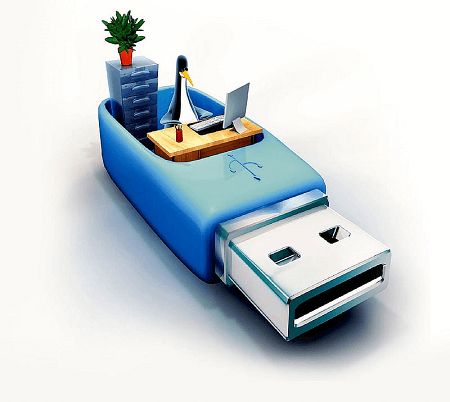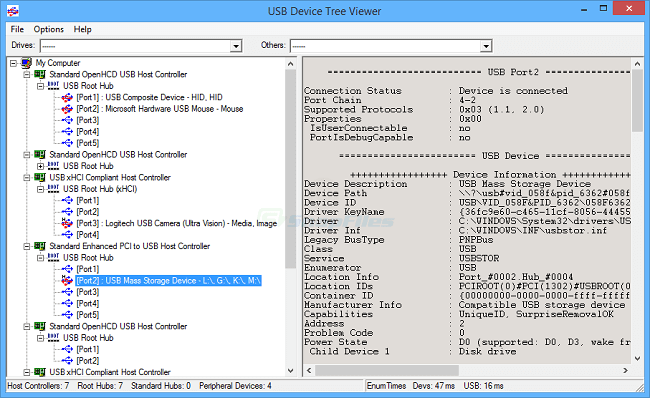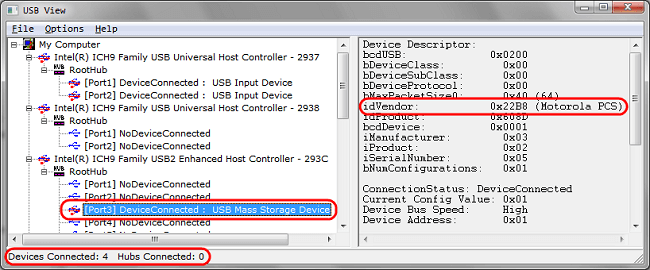Usb Tree View 4.2.2 With Crack Free Download
Download USB tree View 4.2.1 for Windows
Usb Tree View provides detailed information for all USB ports and hubs on a computer in tree view format. A device connected to a port also provides detailed information for the device and connection properties. You can optionally save a full report to a text file. USB Tree Viewer is based on the Microsoft “USB View” sample application found in the Windows Driver Development Kits.
The USB device viewer is a tool that was created for more knowledgeable computer users. In addition, it offers information on how your USB devices are configured, down to the most insignificant detail possible. It doesn’t allow any changes in terms of user input that affect the USB devices themselves, so it works only on an informational basis, meaning that unless you need the offered information, this app will not be of much use to you.

Overview:
The application is not at all unusable or unhelpful. Tree viewer download On the contrary, if you need the precise information it offers, such as BUS types, drive letters, COM ports, and other various statistics regarding power management and the various connected devices, then you’re on. However, if you’re not really designing an application or some sort of hardware that works with this information, the only alternative is to actually use this app to learn the meaning of these elements. In addition, the interface is functional, meaning there aren’t any bells and whistles, just a simple, accessible interface.
Another, more down-to-earth prospect of using this app is to find errors or faulty elements in your configuration. There are plenty of situations that require a thorough analysis of the USB web in order to discover and isolate issues such as faulty drivers or defective components.
Particular application:
Thus, this particular application might not be aimed at all the individuals out there, yet it can still be relevant to those who understand its purpose on account of the information it has to offer and show about USB devices and hubs. In addition, USB Tree Viewer is a small application that interfaces with the Microsoft “USB View” developer tool, which provides detailed information about connected USB devices.
The program, as the name might suggest, features a tree-like view of devices connected. Browsing through USB controllers and connected devices will display a lot of different technical information about the particular device. USB Device Tree Viewer provides details about connection status, driver description, power state, address, etc.
USB devices and file hierarchy:
Device Tree Viewer is a free file-explorer application that has similar features to File Explorer and Q-Dir. However, its primary focus is on USB devices and file hierarchy, while you can also see the relationships between them. There are various layout windows you can use, each one separated by multiple panels. You’ll also see drop-down boxes that are similar to the Windows 10 device explorer.
As its main function, the USB device reader lets you access the files on external devices to see the details and properties. It’s a more advanced form of Windows 10 file explorer, where you view the hierarchical trees and relationships between various devices. Additionally, some of the information includes time, sequence, request details, and USB type.
The program lets you dig a little deeper if you want to see what PnP properties there are for the USB. This information is only available if the external device is PnP hardware, which is also something USB Device Tree Viewer can detect for you.
Screenshots:


Key features of USB Tree View:
- Unauthorized access to information entering and leaving among connected gadgets and an implementation, as well as its retention, presentation, and assessment.
- Specifically, as it relates, the objectives were to determine whether information sent across any host controller hierarchy intercepts actual environments.
- assistance with USB underlying cause adapters
- The ability to remove unused information from the data analysis
- Changing between originating and received packages
- It provide assistance for Removable media
- This product has ability to read gadget information
- Additionally, the ability to terminate surveillance after receiving certain data
- Users could gather data and keep it inside an executable for examination.
- Information collection and exportation to Text, Excel, Servlets, or Web pages.
What’s the new USB Tree View?
Usb tree view can be used on a computer running Windows 11 or Windows 10. Previous versions of the OS shouldn’t be a problem, with Windows 8 and Windows 7 having been tested. It comes in both 32-bit and 64-bit downloads.
System Requirements:
- Supported OS: Windows 10, Windows 8.1, and Windows 7
- RAM (Memory): 2 GB RAM (4 GB recommended)
- Free Hard Disk Space: 200 MB or more
How to Install USB Tree View:
- Configure the odds across a connection according to their preferred model and software.
- Then, according to their machine architecture, access the Cracking Brunel University Directory and unzip the unlocked download link.
- Additionally, insert the keyed package into the Microsoft C > Programs > Device82 directory.
- Users were using the given set of credentials in program enrollment boxes after running the program.
- Everything Complete. A completely repaired USB through an Internet backbone programmer is available.
Conclusion:
Online USB device reader Serial Key 2024 appears to examine your computer’s configuration and display details about the attached presenter microcontroller, such as the manufacturer, software, board type, data gathering tools, reallocation, child devices, storage labeling, Internet and experimental connectors, network properties, and status.
But the parameters that such a programmer could access are the identity, summary, and destination of the gadgets; the correlation condition; the operation; the purposefully chosen participants’ geographic location; additional characteristics (like whether the instrument is detachable); and the charging condition.
